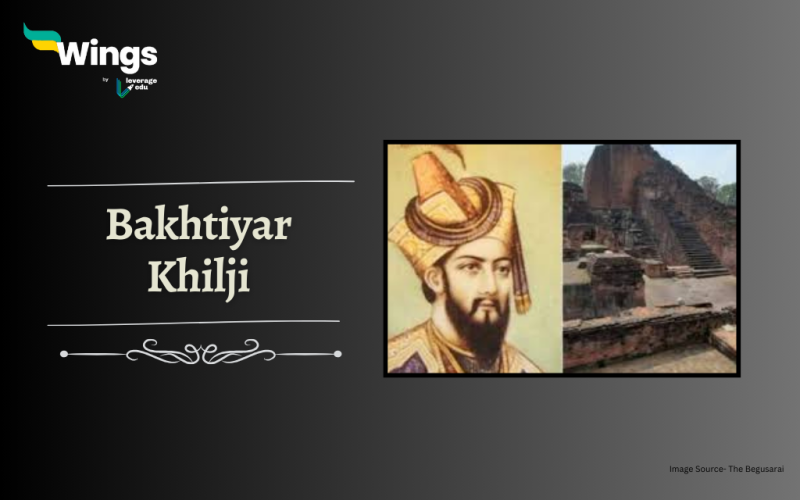Bakhtiyar Khilji is believed to be born in the early 12th century in Central Asia. Unfortunately, historical records about his early life are scarce. While the details of Khilji’s early life are elusive, historical accounts suggest that he underwent rigorous military training, developing the strategic acumen and martial prowess that would later define his conquests. He was a Turko-Afghan military general of the Gurid ruler Muhammad of Ghor. Later he founded the Khalji Sultanate of Bengal and ruled it. In this blog, we will delve into the details of this military general who later became an important ruler in the Bengal region of India.
Table of Contents
| Overview of Bakhtiyar Khilji | |
| Born | c. 1140, Garmsir, Afghanistan |
| Military leader | Ghurid Empire |
| Conquests | Bengal and Bihar (1202-1203) |
| Established | Sultanate of Bengal (1203) |
| Capital | Devkot (present-day Dhaka) |
| Controversies | Destroyed Nalanda University, Brutal Tactics |
| Death | 1206, Devkot |

Early Life of Bakhtyar Khilji
Ikhtiyar al-Din Muhammad Bakhtiyar Khalji was born in the year c. 1140 at Garmsir in Helmand province of Afghanistan.
- His origin is from the Turkic region and was a member of the Khalaj Tribe and spoke the language of Khalaj.
- They were called Kalaje, which in India later became Khalji or Khilji.
Also Read – Alauddin Khilji: Dynasty, Life, Reign, Military Conquests
Arrival in the Indian Subcontinent
It is believed he came to Indian Subcontinent in search of employment in Delhi and Ghazni, but since he was of short height, he got rejected. However, in this search, he went to Badaun present-day Uttar Pradesh, where is was taken into the service of Ghurid governor Hizabrudin Hasan Adib.
- Incorporation into the Delhi Sultanate: Khilji’s entry into the Indian subcontinent transpired in the early 13th century, during the reign of Ghurid ruler Muhammad Ghori, who defeated Prithviraj Chauhan. Initially serving as a military commander under the Delhi Sultanate, Khilji gradually ascended the ranks.
Also Read – Sher Shah Suri: Life, History, Administration
Military Role in India
Bakhtiyar Khilji’s military career in India is majorly characterised by brutal tactics for invasion and the continued destruction of architecture.
- Capture of Bihar (1200): In 1200, Bakhtiyar Khilji orchestrated a significant military feat by capturing Bihar. This conquest marked the commencement of his territorial influence and set the stage for further expansions. In this conquest, he destroyed universities like Odantapuri, Vikarmshila University and Nalanda University. He also sacked many Buddhist Monastries which were chronicled by Minhaj-i-Siraj in “Tabaqat-i-Nasiri”.
- Conquest of Bengal (1203): The zenith of Khilji’s military achievements occurred in 1203 with the conquest of Bengal. This triumph solidified his standing as a potent force in the region and expanded the sway of the Delhi Sultanate.
During the time of invasion, the powerful Sena Dynasty was in a state of decline and Lakshmana Sena was the ruler of the Bengal Region. It is believed that Khilji surprisingly attacked the city of Nabadwip with only 18 horsemen from his army and proceeded so fast that it came as a surprise to the Sena Dynasty. The Sena ruler being unprepared had to flee from the scene. Later, Khilji captured the capital city of Gauda of Bengal and formed the Dynasty of Bengal.
It was because of the large amount of loot and successful conquests, that he was also honoured by Qutubuddin Aibak.
- Islam’s Expansion: Khilji’s campaigns played a role in the geographical expansion of Islam across the Indian subcontinent. His conquests resulted in the establishment of Muslim rule in regions of Bihar and Bengal.
- The Tibet Attack (1206): In his military conquest, he attacked Tibet, as it was a major source for the supply of horses and trade with Bengal. But he suffered a shameful and disastrous defeat at the Chumbi Valley from the Tibetan guerilla forces.
Also Read – Slave Dynasty Important UPSC Notes
Death of Bakhtiyar Khilji
It was from the defeat at the hands of Tibetan forces that he was depressed and was resting in Devkot. Being in a state of exhaustion and illness, one of his main generals taking advantage found him bedridden. Ali Mardan Khilji was the general and stabbed Khilji until he died in the year c. 1206.
Controversies of Bakhtiyar Khilji
Among the controversial aspects of Khilji’s legacy is the alleged destruction of the Nalanda University. While historical accounts differ, some sources attribute the demise of this renowned seat of learning to Khilji’s military campaigns.
The legacy of Bakhtiyar Khilji remains subject to ongoing historical debates. Scholars continue to scrutinize and reinterpret available sources and strive to provide a comprehensive understanding of this complex and intriguing historical figure.
Bakhtiyar Khilji with his mysterious origins and impactful conquests, occupies a distinctive place in the narrative of medieval Indian history. Shrouded in mystery this ruler has the legacy of erecting madrasas, mosques and khanqahs while minting coins in his rule. His successor was Muhammad Shiran Khalji, who further took the position as a military general ruler.
Relevant Blogs
| Ibn Battuta | List of All the Khilji Rulers |
| Kushan Dynasty | Battle of Tarain |
| Khilji Dynasty (1290–1320) | Lodi Dynasty |
| Haryanka Dynasty | Gupta Empire |
| Rashrtrakutas Dynasty | Sayyid Dynasty |
That’s all about Bakhtiyar Khilji! If you want to know more about topics like this, then visit our general knowledge page! Alternatively, you can also read our blog on general knowledge for competitive exams!
 One app for all your study abroad needs
One app for all your study abroad needs













